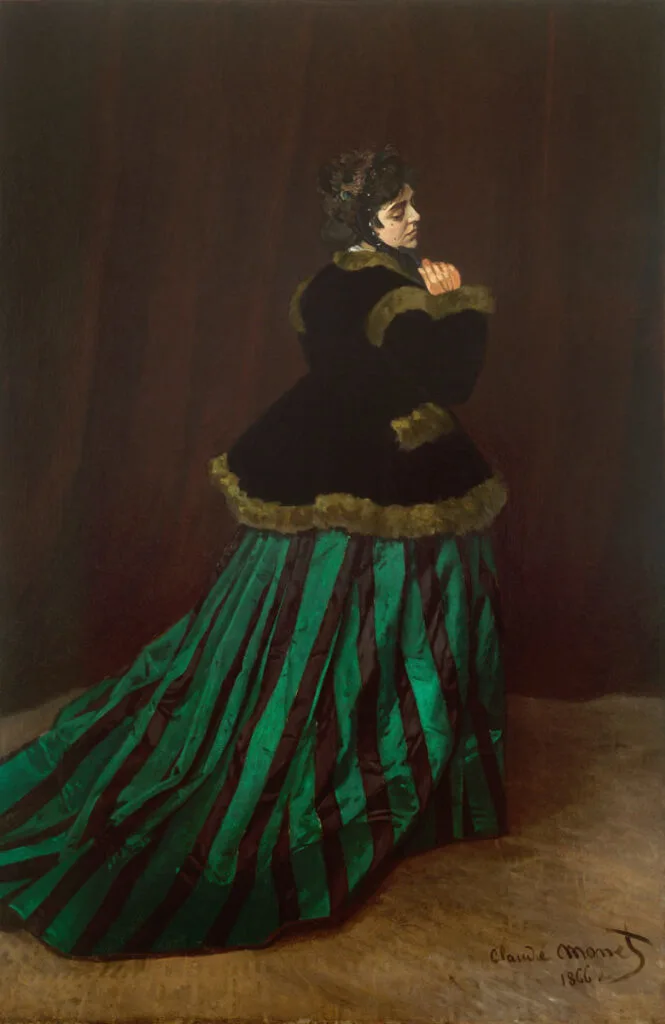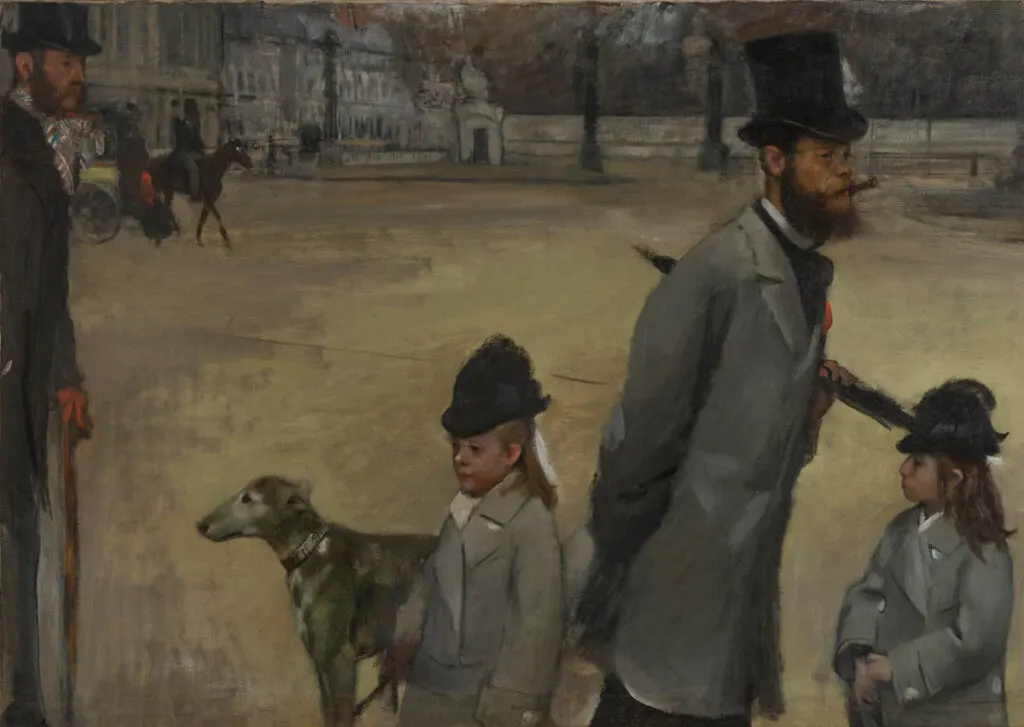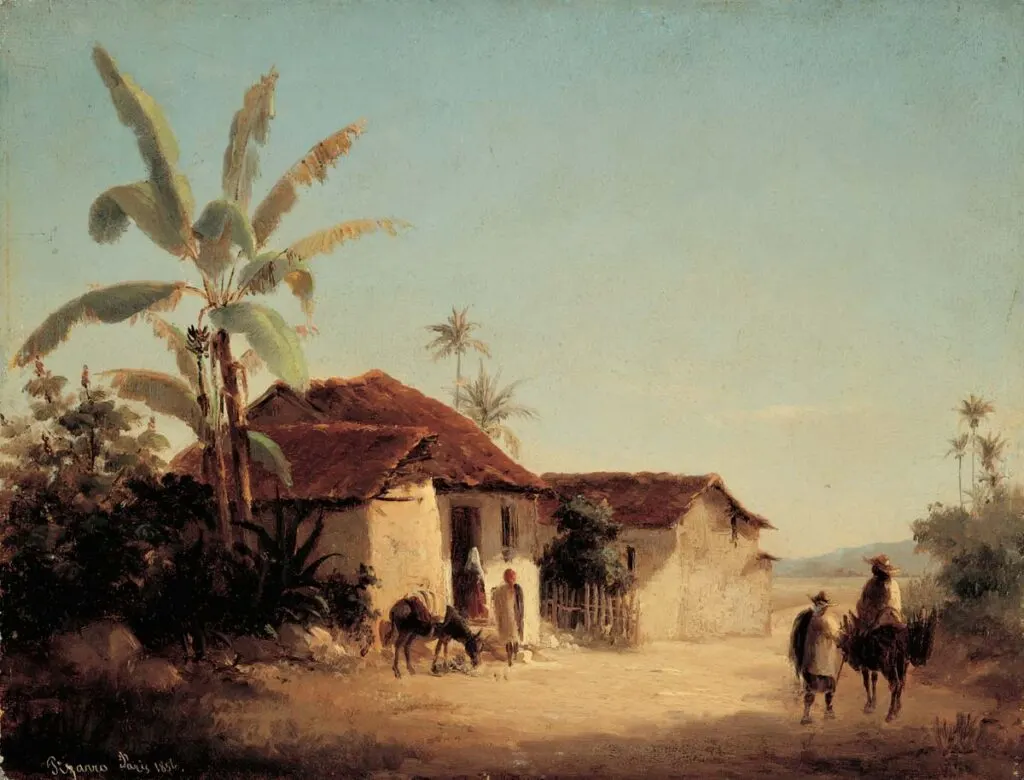Art can cause our souls to bubble with excitement, and French painters are masters of soul speak.
Inspiration and new concepts are never far along, thanks to the internet, but early painters and artists often traveled and studied extensively for the same privilege.
Let’s explore some of the most prominent French painters and how the journey that led them to shape the modern world of art.
By reading this post, you’ll get to know the people behind the famous French paintings, explore different painting styles, familiarize yourself with the contributions of various French painters, and marvel at the artwork of French painters according to a timeline.
French Realist Painters
Rosa Bonheur

Rosa Bonheur, born on 16 March 1822, lived until 25 May 1899.
She had the title of animalière among French painters – a female artist who specialized in portraying animals with absolute realism.
Bonheur also created sculptures in a realistic style. Admirers widely considered her the most renowned female painter of the nineteenth century.
Among her paintings, Ploughing in the Nivernais and Le marché aux chevaux (The Horse Fair) are some of her signature works.
- Labourage Nivernais (Ploughing in the Nivernais), 1849 – This painting portrays two oxen teams plowing land, accentuating a deep commitment to the earth. Admirers believe George Sand’s 1846 novel La Mare au Diable inspired Bonheur to paint this masterpiece. You can view its splendor at the Musée d’Orsay in Paris.
- Le marché aux chevaux (The Horse Fair), 1852 to 1855 – This art piece portrays a horse market on Boulevard de l’Hôpital in Paris and dealers selling their magnificent steeds. Cornelius Vanderbilt II donated it to New York’s Metropolitan Museum of Art, where you can enjoy its beauty in Gallery 812.
More French Realist Painters:
- Gustave Courbet (1819-1877)
- Jean-François Millet (1814-1875)
French Neoclassical Painters
Jacques-Louis David

Jacques-Louis David was born on 30 August 1748 and was one of the most famous painters of France who dabbled in the Neoclassical style.
In fact, his talent had others deem him the preeminent painter of the era. He painted until 29 December 1825.
During the 1780s, he employed an intellectual style of portraying historical paintings, greatly influencing the shift from the traditional Rococo style.
The new technique also coincided with the end of the Ancien Régime – abolishing the French social system of monarchy and nobility.
David lived an eventful life submerged in politics. As such, he painted several iconic paintings.
- Mademoiselle Guimard as Terpsichore, 1774 – 1775
- The Portrait of Count Stanislas Potocki, 1781
- Oath of the Horatii, 1784
- The Death of Socrates, 1787
- The Lictors Bring to Brutus the Bodies of His Sons, 1789 – a famous French Revolution painting
- Le Serment du Jeu de paume (The Tennis Court Oath), 1792
- Death of Marat, 1793
- The Intervention of the Sabine Women, 1799
- Napoleon at the Saint-Bernard Pass, 1801
- The Coronation of Napoleon, 1806
- The Emperor Napoleon in His Study at the Tuileries, 1812
- Emmanuel Joseph Sieyès, 1817
- The Sisters Zénaïde and Charlotte Bonaparte, 1821
- Mars désarmé par Vénus (Mars Being Disarmed by Venus), 1824
More French Neoclassical Painters:
- Jean-Auguste-Dominique Ingres (1780-1867)
French Impressionist Painters
Claude Monet

Oscar-Claude Monet was born on 14 November 1840 and was among the most influential French painters of his time.
As one of the most famous French people, this prominent artist was the founder of impressionist painting, which many consider a crucial precursor to modernism, especially in his approach to painting nature as his brilliant mind perceived it. He passed on 5 December 1925.
Interestingly, Claude Monet received his first drawing lessons from Jacques-François Ochard, a previous art student of Jacques-Louis David.
Monet was exceptionally skilled in Plein air or outdoor landscape painting.
His skill led him to coin the phrase Impressionism which derived from one of his most well-known paintings titled Impression, Soleil levant (Impression, Sunrise).
His other famous paintings include The Woman in the Green Dress and Le Déjeuner sur l’herbe.
- Le Déjeuner sur l’herbe, 1865 to 1866 – Le Déjeuner sur l’herbe was a creation meant as a response to fellow artist Édouard Manet’s 1863 work of art. While Monet didn’t finish the painting, two fragments exist in the Musée d’Orsay in Paris and a more modest 1866 version in the Pushkin Museum in Moscow.
- The Woman in the Green Dress, 1867 – This is a painting of Camille Doncieux, Monet’s wife-to-be future wife. He received positive feedback from critics when he submitted the artwork to the Paris Salon of 1866. It currently sits on display at Kunsthalle Bremen, the art museum in Bremen, Germany.
Edgar Degas

Edgar Degas, born on 19 July 1834, specialized in Impressionist works of art, mainly oil paintings and pastel drawings.
His love for the arts also had him create bronze sculptures, drawings, and prints. He passed on 27 September 1917.
Most admirers and French painters of his era knew him to have a flare for the subject of dance, with several of his art pieces, like La Classe de Danse (The Dance Class).
He preferred to match the term realist to his art rather than impressionism because he did not paint outdoors.
He created several notable works of art, which included:
- A Cotton Office in New Orleans, 1873
- The Orchestra of the Opera, 1870 – Musée d’Orsay
- La Classe de danse (The Ballet Class), 1871 – 1874
- Orchestra Musicians, 1872 – 1876
- Place de la Concorde, 1875
- L’Absinthe (In a café), 1876
- At the Races, 1877 – 1880
- Woman Combing her Hair, 1884 – 1886
- At The Stock Exchange, 1878 – 1879
- Miss La La at the Cirque Fernando, 1879
- Dancers, 1900
Camille Pissarro

Jacob Abraham Camille Pissarro was born on 10 July 1830 and specialized in two main styles: Neo-Impressionism and Impressionism.
He studied with some leading French painters, like Jean-Baptiste-Camille Corot and Gustave Courbet.
His work with Neo-impressionism led him to create art alongside Paul Signac and Georges Seurat. He passed on 13 November 1903.
He painted several beautiful outdoor sceneries:
- Paysage tropical avec masureset palmiers (Landscape with Farmhouses and Palm Trees), 1856
- Jalais Hill, Pontoise, 1867
- Entrée du village de Voisins, 1869
- Pont Boieldieu in Rouen, Rainy Weather, 1896
- Fenaison à Éragny (Hay Harvest at Éragny), 1901
- Autoportrait au chapeau (Self-Portrait with Hat), 1903
Pierre-Auguste Renoir

Pierre-Auguste Renoir, born on 25 February 1841, passed on 3 December 1919.
His works made him a leading painter in the techniques of impressionism. He adored portraying the sensuality of whatever he created, particularly that of femininity.
Renoir received much of his inspiration and technique from other French painters like Édouard Manet and Camille Pissarro.
When the Salon rejected most of the paintings he submitted, he met with Pissarro, Sisley, and Monet in April 1874 to host the first Impressionist exhibition.
Renoir made a lasting impact on the world of art, particularly with paintings like:
- La loge, The Theater Box, 1874
- La Balançoire (The Swing), 1876
- Bal du moulin de la Galette (Bal du moulin de la Galette), 1876
- Le déjeuner des canotiers (Luncheon of the Boating Party), 1880 – 1881
- Sur la terrasse (On the Terrasse), 1881
- Baigneuse blonde (Blond Bather), 1881
- Jeunes filles au piano (Young Girls at the Piano), 1892
More French Impressionist Painters:
- Édouard Manet (1832-1883) – Olympia was probably one of his most controversial paintings
- Berthe Morisot (1841-1895)
French Post-Impressionist Painters
Paul Gauguin

Eugène Henri Paul Gauguin was born on 7 June 1848, and he employed a Synthetist technique and experimented with various colors, unlike French painters who focused on Impressionism.
Paul Gauguin passed on 8 May 1903 and spent his last years in French Polynesia.
As a result, the last of his paintings depict inspirations from this region. His work inspired other famous artists like Henri Matisse and Pablo Picasso.
He was also on friendly terms with Vincent van Gogh and his younger brother Theo.
Gauguin produced many beautiful paintings, with some of his greatest works including:
- Les Maraîchers de Vaugirard, ou Les Jardins du marché de Vaugirard (The Market Gardens of Vaugirard), 1879
- Nave nave moe (Sacred Spring: Sweet Dreams), 1894
- Mahana no Atua (Day of the God), 1894
- D’où venons-nous ? Que sommes-nous ? Où allons-nous ? (Where do we come from? Who are we? Where are we going?), 1897
- Végétation tropicale, Martinique (Martinique Landscape), 1887
Paul Cézanne

The famous painter Paul Cézanne, born on 19 January 1839, dabbled with Post-Impressionist techniques, so much so that critics view him as setting the stage for art styles changing between the 19th and 20th centuries – specifically, Cubism.
Paul Cézanne passed on 22 October 1906, but not before bridging the gap between traditional and modern art styles.
Cézanne’s creative artworks consist of brush strokes that favor exploration and include several planes of colors that mark his dedication toward his creations.
Among his most famous artistic creations, there were a few that pay homage to his signature techniques:
- Le Printemps, 1860
- Jeune fille au piano—Ouverture de Tannhäuser (Jeune Fille au piano (Girl at the Piano – The Overture to Tannhauser), 1868
- Une moderne Olympia (A Modern Olympia), 1873 – 1874
- Le moulin sur la Couleuvre à Pontoise (Mill on the Couleuvre at Pontoise), 1881
- Le Bassin du Jas de Bouffan, 1876
- Pyramide de crânes (Pyramid of Skulls), 1898 – 1900
Henri de Toulouse-Lautrec

Count Henri Marie Raymond de Toulouse-Lautrec-Monfa was born on 24 November 1864 and created magnificent painters related to the theater in the 19th century.
He was a Post-Impressionist, skilled draughtsman, illustrator, caricaturist, and printmaker. He passed on 9 September 1901.
His theatrical paintings often included themes of elegancy, provocation, and the wild affairs of his time.
One of his earliest paintings, La Blanchisseuse, sold for a record US$22.4 million at Christie’s auction house in 2005.
His most famous paintings include the following:
- The Marble Polisher, 1882 – 1887
- La Blanchisseuse, 1884 – 1888
- Au cirque Fernando, l’écuyère (Equestrienne (at the cirque fernando), 1888
- Rousse, 1889
- At the Moulin Rouge, 1890
- La Goulue arrivant au Moulin Rouge (accompagnée de deux femmes) (La Goulue arriving at the Moulin Rouge), 1892
- Rue des Moulins, 1894
Henri Matisse

Henri Émile Benoît Matisse was born on 31 December 1869 and held the title of visual artist.
The world of painting knew him for his concepts of color and refined draughtsmanship. He passed on 3 November 1954.
Along with prominent painters like Pablo Picasso, Matisse played a significant role in shaping modern visual arts.
His achievements were partly due to his sculptor and printmaker talents.
His spectacular use of color between 1900 and 1905 earned him the respect and title of “Fauve” (wild beast).
The Wild Beasts were a collective of early 20th-century artists who favored vivid colors over realism.
His works after 1906 took on new techniques where he highlighted decorative patterns and flat formations.
He created several magnificent art pieces, and the best in his collection are:
- Compotier de pommes et oranges (Still Life with Compote, Apples, and Oranges), 1899
- Femme au chapeau (Woman with a Hat), 1905
- Les toits de Collioure, 1905
- Nu (Carmelita), 1904
- Luxe, Calme et Volupté (Luxury, Calm and Pleasure), 1904
- Vase, Bottle and Fruit, 1906
More French Post-Impressionist Painters:
- Henri Rousseau (1844-1910)
- Georges Seurat (1859-1891)
- Georges Braque (1882-1963) – he was one of the most famous French painters of the twentieth century
French Romantic Painters
Eugène Delacroix

Ferdinand Victor Eugène Delacroix was born in the late 18th century on 26 April 1798 and focused on creating Romantic works of art.
Because of his unparalleled talent, French painters saw it fit that he took on the mantle of the leader of the French Romantic school. He passed on 13 August 1863.
Unlike rival painters, Delacroix focused on color and movement in his paintings, drawing inspiration from many Venetian Renaissance painters like Sir Peter Paul Rubens.
He loved to include combining the themes of romance and drama, which led him to travel to North Africa for something extraordinary.
His brushstroke techniques and use of color significantly impacted Impressionist painters, and his search for exoticism inspired Symbolist artists.
He created numerous works of art that impacted other French artists, including:
- Dante et Virgile aux enfers, dit aussi La Barque de Dante (Dante and Virgil in Hell, also known as The Barque of Dante), 1822
- Scène des massacres de Scio (The Massacre at Chios), 1824
- La Grèce sur les ruines de Missolonghi (Greece Expiring on the Ruins of Missolonghi), 1826
- The Murder of the Bishop of Liège, 1827
- Liberty Leading the People, 1830
- Self-portrait with Green Vest, 1837
- The Fanatics of Tangier, 1837 – 1838
- Médée, 1838
- La mort de Sardanapale (Death of Sardanapalus), 1844
More French Romantic Painters:
- Théodore Géricault (1791-1824)
Final Words on French Artists
These French painters have helped shape the history of art. Being influential artists, they are an essential part of French culture, and studying art equals learning about these masters and their masterpieces.
We hope you learned interesting facts about these French painters and their art. Feel free to share the article and help us spread the word.
11 French Painters
- Rosa Bonheur
- Jacques-Louis David
- Claude Monet
- Edgar Degas
- Camille Pissarro
- Pierre-Auguste Renoir
- Paul Gauguin
- Paul Cézanne
- Henri de Toulouse-Lautrec
- Henri Matisse
- Eugène Delacroix
Don’t Forget About Travel Insurance!
Before you leave for France, make sure you have a valid travel insurance policy because accidents happen on the road. We have been paying for Safety Wing travel insurance for a little over a year now, and we happily recommend them to our family and friends.
If you get sick, injured, or have your stuff stolen, you'll be happy to have the ability to pay for your medical bills or replace what was stolen.
Because, for just a couple of dollars a day (depending on how long your policy is for), you're going to get lots of things covered. Be smart and get travel insurance.
